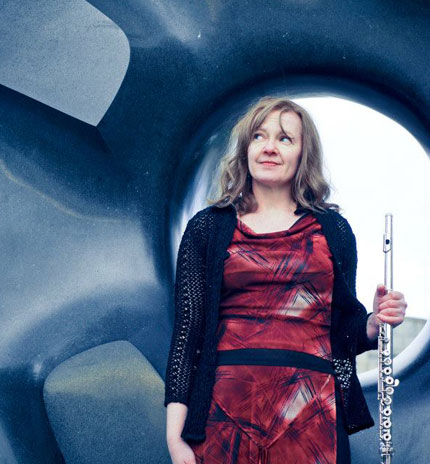“Music has always been the constant in my life,” teenage Sarah Bassingthwaighte realized when it came time to make those big life decisions about college majors.

Sarah started piano lessons at age 4, composing when she was 5 (she still has these early works, notated in very large script), and flute at age 9. A lingering interest in composition led to formal study at Indiana University (while pursuing a flute degree) with composers like Harvey Sollberger. Hearing some of the new ideas and new sounds that these composers came up with was eye-opening for Sarah – “There’s all this other stuff you can do!” – and she felt like a door had been opened. Little did she know, there would eventually be an entire house of doors.
 House of Doors is a concerto for flute and orchestra which will be premiered by Merrie Siegel and the Northwest Symphony Orchestra under the baton of Anthony Spain on Saturday, April 30 at 8pm. It was composed in the last 6 months, and it’s the first piece she’s written for flute that she is not premiering, which presented some challenges. “I had to see if my notation, my ability to communicate my ideas, worked. When I premiere my own piece, I just play what was in my head in the first place and I’m not even looking at the page. But now I have to see if it works!”
House of Doors is a concerto for flute and orchestra which will be premiered by Merrie Siegel and the Northwest Symphony Orchestra under the baton of Anthony Spain on Saturday, April 30 at 8pm. It was composed in the last 6 months, and it’s the first piece she’s written for flute that she is not premiering, which presented some challenges. “I had to see if my notation, my ability to communicate my ideas, worked. When I premiere my own piece, I just play what was in my head in the first place and I’m not even looking at the page. But now I have to see if it works!”
photo credit: Mark Manning
The inspiration for this concerto came from a Buddhist meditation exercise created by Anna Wise of the same name, House of Doors, and it was simultaneously “the most fun” and a “profound experience” for Sarah. Here’s how it works, in a nutshell: You’re in a house that you’ve invented and there’s a hallway with many doors. All the doors look different and you get to go and open any door you want, walk inside the room, look at it in as much detail as you can, walk around, see what’s there, change what you want. Then you leave, close the door, and you can go in another one. The idea is not just to hone your observation and imagination but also to get in touch with your ability to change things in your life.
To hear a sneak peek of House of Doors (the flute and piano reduction) click here!

In Sarah’s first experience, she visited three rooms.
First, she walked into a room that initially looked like a normal bedroom, but on deeper examination she saw little plants and tendrils and deeper in, a dark jungle that went for miles and miles full of orchids and vines.
The next door was a dark, hot, uncomfortable red cave with an empty chair under a spotlight. It was a very scary place.
Through the last door, there was no floor, no ceiling, just sky. She stepped into the room and moved about how she wished. Flying, free, and fun.
Those images were powerful to Sarah and became the launching points for the piece. It was first notated graphically with just textures and a few descriptive words – it wasn’t until months after she started composing that notes and rhythms came about. “One thing I’ve loved about composing is connecting with the other arts. In this case, a feeling of motion, maybe dance, of visual arts and finding the place where they all meet and eventually ending up in my field, music, and creating the piece. Even within the field of music, Sarah’s had some variety and departures.
After her time at IU, Sarah took a break from classical music to play bass in punk rock bands. That seemingly “left turn” wasn’t totally unrelated to her classical training and she’s been able to find a link between all types of music. The directness and even some of the experimentalism in classical music transferred to the bands she was playing with and she found that a sense of attitude and sense of humor is present in both.
“I went into music and never looked back. I love it and I’ll never get bored of it.”

The House of Doors Concerto for Flute and Orchestra will be performed on Saturday, April 30 at 8 p.m. at the Highline Performing Arts Center in Burien. For tickets and additional information, please visit this link.


 Karin Stevens:
Karin Stevens: 






 Jessie Polin: This particular concert is unique in that it showcases some of the best chamber music repertoire for winds and brass. Especially with the Stravinsky and Poulenc, we’re exploring the neoclassical style in the context of a small chamber concert.
Jessie Polin: This particular concert is unique in that it showcases some of the best chamber music repertoire for winds and brass. Especially with the Stravinsky and Poulenc, we’re exploring the neoclassical style in the context of a small chamber concert.

